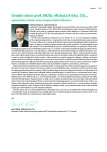Diagnosis and management of metastatic pheochromocytoma and paraganglioma
Authors:
Ivana Jochmanová; Ivica Lazúrová
Authors‘ workplace:
I. interná klinika LF UPJŠ a UNLP, Košice, Slovenská republika
Published in:
Vnitř Lék 2017; 63(9): 580-588
Category:
Reviews
Overview
Pheochromocytoma (PHEO) and paraganglioma (PGL) are rare catecholamine-producing neuroendocrine tumors arising from adrenal medulla or extra-adrenal sympathetic and parasympathetic ganglia. Most of the PHEOs/PGLs are benign tumors, but metastatic disease is common, especially in patients with particular genetic background. Although PHEOs/PGLs were described more than a century ago, diagnosis and therapy of metastatic disease are still challenging. Advances in understanding molecular and metabolic changes associated with tumorigenesis lead us to identification of the background of these tumors. Novel information allowed for development of more precise diagnostic methods and molecular therapeutic targets identification, which will improve care of patients with metastatic PHEO/PGL.
Key words:
diagnostics – management – paraganglioma – pheochromocytoma – therapy
Sources
1. Eisenhofer G, Lenders JW, Siegert G et al. Plasma methoxytyramine: a novel biomarker of metastatic pheochromocytoma and paraganglioma in relation to established risk factors of tumour size, location and SDHB mutation status. Eur J Cancer 2012; 48(11): 1739–1749. Dostupné z DOI: <http://dx.doi.org/10.1016/j.ejca.2011.07.016>.
2. McNeil AR, Blok BH, Koelmeyer TD et al. Phaeochromocytomas discovered during coronial autopsies in Sydney, Melbourne and Auckland. Aust N Z J Med 2000; 30(6): 648–652.
3. Pacak K, Lenders JWM, Eisenhofer G. Pheochromocytoma. Diagnosis, Localization, and Treatment. Willey-Blackwell: Malden (MA) 2007. ISBN 978–1405149501.
4. Lenders JW, Eisenhofer G, Mannelli M et al. Phaeochromocytoma. Lancet 2005; 366(9486): 665–675.
5. Martucci VL, Pacak K. Pheochromocytoma and paraganglioma: diagnosis, genetics, management, and treatment. Curr Probl Cancer 2014; 38(1): 7–41. Dostupné z DOI: <http://dx.doi.org/10.1016/j.currproblcancer.2014.01.001>.
6. Zelinka T, Strauch B, Petrak O et al. Increased blood pressure variability in pheochromocytoma compared to essential hypertension patients. J Hypertens 2005; 23(11): 2033–2039.
7. Adlan MA, Bondugulapati LN, Premawardhana LD. Glucose intolerance and diabetes mellitus in endocrine disorders – two case reports and a review. Curr Diabetes Rev 2010; 6(5): 266–273.
8. Jochmanova I, Pacak K. Pheochromocytoma/Paraganglioma: Update on Diagnosis and Management. In: Levine AC (ed). Adrenal Disorders: Physiology, Pathophysiology and Treatment. Humana Press 2018: in press. ISBN 978–3319624693.
9. Callender GG, Rich T, Lee JE et al. Pheochromocytoma. In: Yao JC, Hoff PM, Hoff AO (eds). Neuroendocrine tumors. Humana Press: New York (NY) 2011, 221–243. ISBN 978–1603279963.
10. Brouwers FM, Lenders JW, Eisenhofer G et al. Pheochromocytoma as an endocrine emergency. Rev Endocr Metab Disord 2003; 4(2): 121–128.
11. Eisenhofer G, Lenders JW, Pacak K. Biochemical diagnosis of pheochromocytoma. Front Horm Res 2004; 31 : 76–106.
12. Eisenhofer G. Peitzsch M. Laboratory evaluation of pheochromocytoma and paraganglioma. Clin Chem 201; 60(12): 1486–1499. Dostupné z DOI: <http://dx.doi.org/10.1373/clinchem.2014.224832>.
13. Lenders JW, Pacak K, Walther MM et al. Biochemical diagnosis of pheochromocytoma: which test is best? JAMA 2002; 287(11): 1427–1434.
14. Pacak K, Eisenhofer G, Ahlman H et al. Pheochromocytoma: recommendations for clinical practice from the First International Symposium. October 2005. Nat Clin Pract Endocrinol Metab 2007; 3(2): 92–102.
15. Eisenhofer G, Goldstein DS, Walther MM et al. Biochemical diagnosis of pheochromocytoma: how to distinguish true - from false-positive test results. J Clin Endocrinol Metab 2003; 88(6): 2656–2666.
16. Hodin R, Lubitz C, Phitayakorn R et al. Diagnosis and management of pheochromocytoma. Curr Probl Surg 2014; 51(4): 151–187. Dostupné z DOI: <http://dx.doi.org/10.1067/j.cpsurg.2013.12.001>.
17. Eisenhofer G, Goldstein DS, Sullivan P et al. Biochemical and clinical manifestations of dopamine-producing paragangliomas: utility of plasma methoxytyramine. J Clin Endocrinol Metab 2005; 90(4): 2068–2075.
18. Jochmanová I, Pacak K. Feochromocytóm a paraganglióm: klinicko-genetické aspekty. Interná medicína 2015; 15(2): 74–77.
19. Eiden LE, Iacangelo A, Hsu CM et al. Chromogranin A synthesis and secretion in chromaffin cells. J Neurochem 1987; 49(1): 65–74.
20. d‘Herbomez M, Do Cao C, Vezzosi D et al. Chromogranin A assay in clinical practice. Ann Endocrinol (Paris) 2010; 71(4): 274–280. Dostupné z DOI: <http://dx.doi.org/10.1016/j.ando.2010.04.004>.
21. Nijhoff MF, Dekkers OM, Vleming LJ et al. ACTH-producing pheochromocytoma: clinical considerations and concise review of the literature. Eur J Intern Med 2009; 20(7): 682–685. Dostupné z DOI: <http://dx.doi.org/10.1016/j.ejim.2009.08.002>.
22. Lenders JW, Duh QY, Eisenhofer G et al. Pheochromocytoma and paraganglioma: an endocrine society clinical practice guideline. J Clin Endocrinol Metab 2014; 99(6): 1915–1942. Dostupné z DOI: <http://dx.doi.org/10.1210/jc.2014–1498>.
23. Pacak K, Timmers HJLM, Eisenhofer G. Pheochromocytoma. In: Jameson JL, DeGroot LJ, De Kretser DM et al (eds). Endocrinology: Adult & pediatric. 2 voll. 7th ed. Elsevier/Saunders: Philadelphia (PA) 2016 : 1902–1930. ISBN 978–0–323–18907–1.
24. Plouin PF, Fitzgerald P, Rich T et al. Metastatic Pheochromocytoma and Paraganglioma: Focus on Therapeutics. Horm Metab Res 2012; 44(5): 390–399. Dostupné z DOI: <http://dx.doi.org/10.1055/s-0031–1299707>.
25. Lloyd RV, Osamura RY, Kloppel G (eds) et al. WHO Classification of Tumours of Endocrine Organs. 4th ed. Vol. 10. WHO/IARC Classification of Tumours. WHO Press 2017. ISBN 978–92–832–4493–6.
26. Eisenhofer G, Bornstein SR, Brouwers FM et al. Malignant pheochromocytoma: current status and initiatives for future progress. Endocr Relat Cancer 2004; 11(3): 423–436.
27. McBrideJF, Atwell TD, Charboneau WJ et al. Minimally invasive treatment of metastatic pheochromocytoma and paraganglioma: efficacy and safety of radiofrequency ablation and cryoablation therapy. J Vasc Interv Radiol 2011; 22(9): 1263–1270. Dostupné z DOI: <http://dx.doi.org/10.1016/j.jvir.2011.06.016>.
28. Jochmanova I, Wolf KI, King KS et al. SDHB-related pheochromocytoma and paraganglioma penetrance and genotype-phenotype correlations. J Cancer Res Clin Oncol 2017; 143(8): 1421–1435. Dostupné z DOI: <http://dx.doi.org/10.1007/s00432–017–2397–3>.
29. Carrasquillo JA, Pandit-Taskar N, Chen CC. I-131 Metaiodobenzylguanidine Therapy of Pheochromocytoma and Paraganglioma. Semin Nucl Med 2016; 46(3): 203–214. Dostupné z DOI: <http://dx.doi.org/10.1053/j.semnuclmed.2016.01.011>.
30. Jochmanova I, Pacak K. Pheochromoctyoma: The First Metabolic Endocrine Cancer. Clin Cancer Res 2016; 22(20): 5001–5011.
Labels
Diabetology Endocrinology Internal medicineArticle was published in
Internal Medicine

2017 Issue 9
Most read in this issue
- Adenosine – a mediator with multisystemic effects (or a hormone?)
- Anabolic steroid induced hypogonadism in men: overview and case report
- Thyroid carcinomas: the present view on diagnostics and therapy
- Primary hyperparathyroidism – new clinical forms of the disease
